WW1 in Alsace - Linge Battle - 63rd Anti Aircraft Regiment - 96th poste semi-fixed
The poppy symbol
 The poppy (also known as papaver rhoeas) generally grows on wheat fields and on the side of the roads on chalky soils.
The poppy (also known as papaver rhoeas) generally grows on wheat fields and on the side of the roads on chalky soils.
In the language of flowers, it means fragile ardour .They are used to celebrate 8 years’ wedding anniversary.
==O=O==
The poppy was adopted by commonwealth countries as a memorial for the soldiers who died on the field of honour, more especially during WW I . This symbol has numerous and international origins.
First of all, poppies were noticed during Napoleonic wars on the graves of dead soldiers, probably because chalk was going upwards due to the digging of the graves.
This phenomenom happened again about 100 years later during WW I not only on the graves but also along the trenches.

Poppies along a trench
==O=O==
The colour of the poppy was also an appropriate symbol for the bloodshed during the trenches war. All this may have inspired Colonel John Mc Crae for his poem.
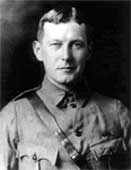
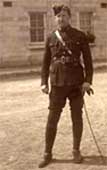
John Mc Crae was born in Guelph, Ontario, on 30th November 1872. He served his country as a volunteer during the South African Boer War. He quit the army in 1904 a captain.
As a doctor and a professor, he was very much appreciated for his enthusiasm, his sense of responsabilities towards his patients as well as his students and fellow teachers.
When Great Britain declared war on Germany on 4th Aug 1914, so did Canada as part of the British Empire. Many Canadians enlisted voluntarily very quickly. In less than three weeks , 45 000 had enlisted and among them John Mc Crae. He was appointed as a surgeon in the first artillery brigade with the grade of M.O. (Medical Officer)
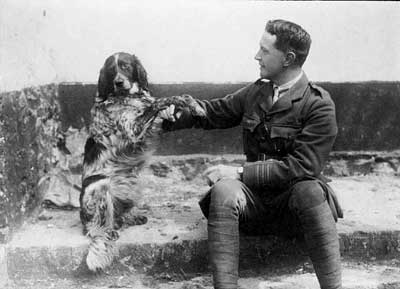
John McCrae in 1914
In april 1915 John McCrae was in the Yper Trenches (Belgian Flanders) which were the seat of bloody fights during WW I . On the 22nd of April the Germans used a toxic chlorinated gas for the first time. (they tested mustard-gas on the same battlefield in july 1917).
Despite the gas, the Canadian soldiers fought without respite and held the position. John McCrae was in charge of a medical post located in a shelter dug into the banks of the Yser canal and attended to hundreds of casualties. He was surrounded by dead or dying people. In a letter to his mother he wrote :
The general impression in my mind is of a nightmare. We have been in the most bitter of fights. For seventeen days and seventeen nights none of us have had our clothes off, nor our boots even, except occasionally. In all that time while I was awake, gunfire and rifle fire never ceased for sixty seconds... And behind it all was the constant background of the sights of the dead, the wounded, the maimed, and a terrible anxiety lest the line should give way.
On May 2nd Lieutenant Alexis Helmer, 22, a friend of McCrae’s was killed in action. After he had wrapped the remains of his body into a blanket, McCrae led himself the funeral of his friend. lexis Helmer was buried in a very simple grave, marked by a plain wooden cross, next to some other graves among which poppies had already started to grow.
John McCrae was so shocked that on the following day he could not do anything else but write this poem « In Flanders’ fields ».

In Flanders' Fields the poppies blow
Between the crosses, row on row,
That mark our place; and in the sky
The larks, still bravely singing fly
Scarce heard amidst the guns below.
We are the Dead. Short days ago
We lived, felt dawn, saw sunset glow,
Loved and were loved, and now we lie
in Flanders' fields.
Take up our quarrel with the foe,
To you from failing hands we throw
The torch - be yours to hold it high;
If ye break faith with us who die,
We shall not sleep though poppies grow
In Flanders' fields
Dans les champs des Flandres, les coquelicots
Sont parsemés de lot en lot
Auprès des croix ; et dans l'espace
Les alouettes devenues lasses
Mêlent leurs chants au sifflement des obusiers.
Nous sommes morts,
Nous qui songions la veille encor'
À nos parents, à nos amis,
C'est nous qui reposons ici,
Dans les champs des Flandres.
À vous jeunes désabusés,
À vous de porter l'oriflamme
Et de garder au fond de l'âme
Le goût de vivre en liberté.
Acceptez le défi, sinon
Les coquelicots se faneront
Dans les champs des Flandres.
Shortly after, he was appointed to the General Canadian Hospital Nr 3 in France. It was located betwwen Dannes and Camiers in Pas de Calais and was mainly composed of huge canvas tents. As it was too damp and cold they had to relocate it in the ruins of a College in Boulogne. There were more than 1 500 beds in this hospital : Casualties would come from the Somme, Vimy, Yper, Arras and Passchendaele where Canadians were giving a tough battle to the ennemy.
In Summer 1917, McCrae suffered from severe asthma and bronchitis. In January 1918 he was promoted1st medical consultant for the 1st British Army and he diagnosed himself with pneumonia on the same day. His health went on deteriorating and he died on january 28th 1918.
John McCrae was paid the last tribute and was buried in Wimereux Cemetery, near Boulogne.
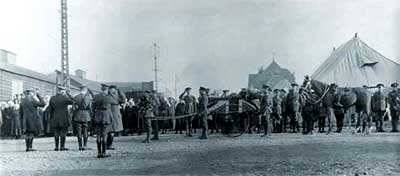
Burial John McRae
==O=O==
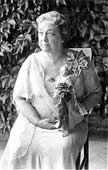
Mrs Moina Belle Mickaels was an American teacher from Georgia. She was a voluntary member of the YMCA, a charity founded by a British minister in 1844. Two days before Armistice she read McCrae’s poem. She was deeply affected and as an answer to McCrae she wrote the poem : « We shall keep the faith »
Oh! you who sleep in Flanders Fields,
Sleep sweet - to rise anew!
We caught the torch you threw
And holding high, we keep the Faith
With All who died.
We cherish, too, the poppy red
That grows on fields where valor led ;
It seems to signal to the skies
That blood of heroes never dies,
But lends a lustre to the red
Of the flower that blooms above the dead
In Flanders Fields.
And now the Torch and Poppy Red
We wear in honor of our dead.
Fear not that ye have died for naught ;
We'll teach the lesson that ye wrought
In Flanders Fields.
Oh ! Vous qui dormez dans les champs des Flandres
Dormez bien - pour vous lever à nouveau ;
Nous avons repris le flambeau par vous brandi
Et le portant bien haut, nous respectons
La parole donnée par les morts.
Nous aussi chérissons le rouge du coquelicot
Qui pousse dans les champs où le courage régnait.
Il semble dire au ciel
Que le sang des héros est éternel.
Mais il donne au rouge l'éclat
Des fleurs qui s'épanouissent au-dessus des morts
Dans les champs de Flandres.
Et maintenant le flambeau et le coquelicot rouge
Que nous portons en l'honneur de nos morts.
Afin que vous ne soyez pas morts pour rien ;
Transmettra le message que vous nous avez laissé
Dans les champs de Flandres.
She decided to wear a poppy at the buttonhole for the rest of the year as a remembrance af all the people who had died during the war.
In 1920 Mrs Guérin, a French member of the YMCA met Moina Belle Mickaels in the USA. She created the association « American and French Children’s League » to sell, on Armistice Days, handmade , woven poppies in order to collect money to help children in the countries that had been devastated by the war in Europe.
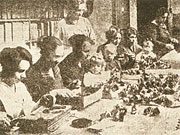
French producing poppies

In 1921, Field Marshal Douglas Haig, Commander-in-Chief of the British Armies in France and Belgium, heard of Mrs Guérin’s initiative and encouraged the organisation of the British poppy Day Appel in order raise funds to support poor and / or crippled ex-service men.
The same year, as she was visiting Canada, Mrs Guérin succeeded in convincing the ex-service men associations to adopt the poppy as the symbol for the remembrance used for collecting money.
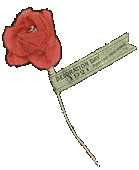
On the first year, artificial poppies were bought in France from Mrs Guérin’s organization but as early as 1922 the different countries started manufacturing their own poppies. In Canada, they were made by disabled ex-service men.
Today the poppy is a very strong symbol in Canada and Great Britain. The poppy campaign is a very important money collecting action for the Royal Canadian Legion. The money they get is used to buy medical equipment, to subsidize medical research, healthcare centres, home services.